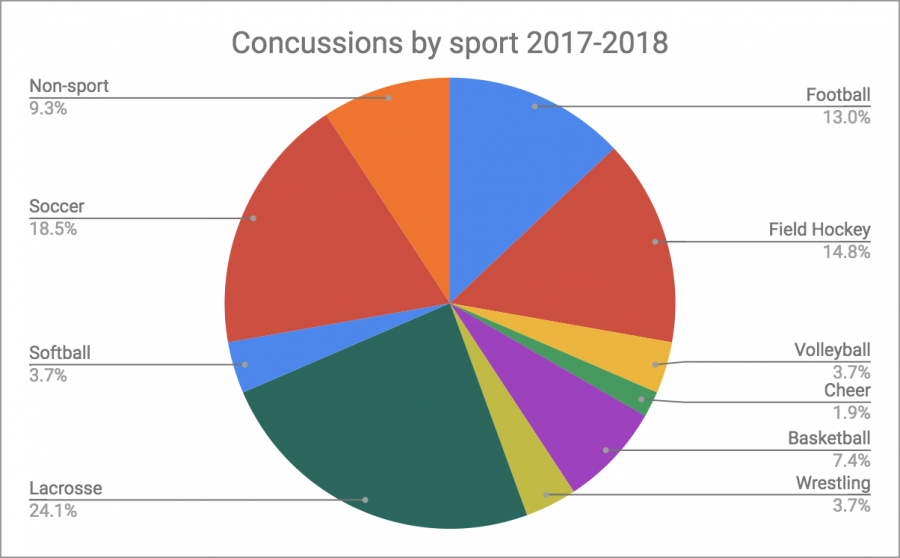Concussions: The Hard Hitting Story at C.H.S.
More stories from Hunter Randle
Graph Curtesy of C.H.S. Athletic Department
Graph showing the spread of what sports carry what number of concussions
Sports have become a hot topic nationwide, and C.H.S. is no exception. Last year alone there were 55 concussions between both girls and boys, sports and non-sports. This year we have had 6 so far, all sports related.
As a community that has a large populous that lives for the outdoors whether sports related or not, concussions are expected but these numbers are alarming. Last year, of the 55 concussions that were received, 5 of them or 9.3% were non-sport related. 28 of them came from contact sports (Lacrosse, Field Hockey, and Football), all which one would expect from such sports. And the remaining 22 concussions came from all remaining sports, with most resulting in the same general amount of head injuries.
Reporters recently spoke with our own Head Athletic Trainer Joella Matheny, and she gave insight into the truth behind all of the head injuries.
“Every concussion is different, the same person may have multiple concussions each one different. Two students in the same class may have concussions and be totally different.” This idea is what makes these head injuries so difficult for both doctors to treat and teachers to accommodate.
The second serious trouble that staff has when dealing with concussions is knowing when the brain really has recovered and is ready to start in the classroom again. However, Mrs. Matheny said that the staff at C.H.S. is great when dealing with concussions and getting students back and acclimated to the learning environment. Many of the teachers have a past that included participation in sports teams, which increases their understanding of how hard a sustained head injury is.
Apart from the positive feedback that Mrs. Matheny gave us, some students that we surveyed had differed opinions on the way that teachers handle concussions.
Kit Tremaglio (11) gave the K.T.R. insight into what returning to school after a concussion is really like saying,“I came back to school too early because of stress over classes, some teachers were better than others. It would have helped if I were able to wait a few days after coming back in order to take any tests missed because you can’t study when you have a concussion so it makes no sense to take a test your first day back.”
Shaun Barbour (10)also sustained a concussion this school year and had an interesting perspective,“Having the concussion was nice cause you could miss some school but, stopped you from doing most things it hurts to watch tv, look at your phone, and read. With the recovery also depending on each person the down time still sucks” said Shaun Barbour(11) after sustaining a concussion on the football field this past season.
It is responses like these that make you wonder whether there is willingness by teachers across the board to help students or if it is only a select number of teachers that are so accommodating. This is an issue that needs to be addressed by the school because as a student, there needs to be gradual return into the classroom across the board.
Reporters also talked to Mrs. Matheny about what sports lead to more head injuries. “Obviously more collision or contact sports are going to see higher numbers of concussions. However, there have been many changes to these sports to help avoid concussive blows especially during practice.” It’s changes like these that stretch the longevity of contact sports for generations to come. The city schools have been making a large push to increase education on concussions for both parents and teachers to make these life changing head injuries as easy as possible on the student.
Discoveries about the long term effects that concussions can have on the brain have resulted in concussions being seen as a more serious injury. This Reporter has seen these effects first hand and he can tell you that nobody, absolutely nobody should have the live the remainder of their life with them. His grandfather, Sonny Randle played in the NFL for over 10 years with the Cardinals, Cowboys, and 49ers. In a time where safety was merely a thought in the back of everybody’s mind. At age 75 he began to show serious signs of dementia and alzheimers, which both progressed at an alarming rate and he passed away at age 81. The consequences of these injuries are unseen to the blind eye, but it is time to change that.
Donate to support the budding student journalists of Charlottesville High School! Your contribution will allow us to provide unique content to members of our school community such as print issues, special segments of our news program, and fun events; as well as keeping this useful site up and running. Anything helps!


